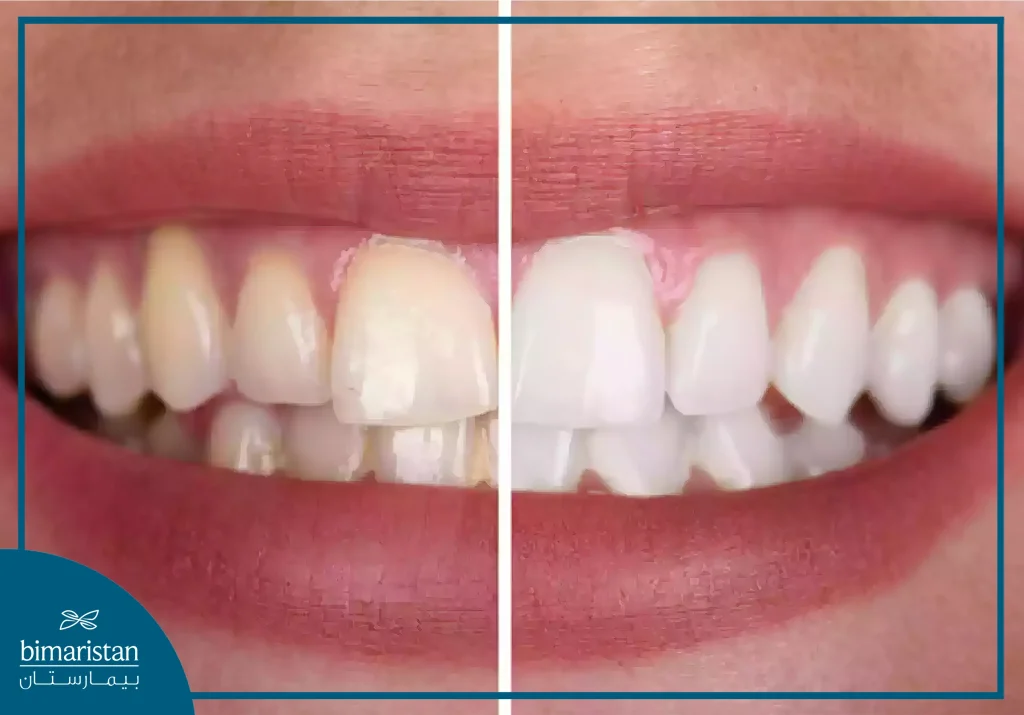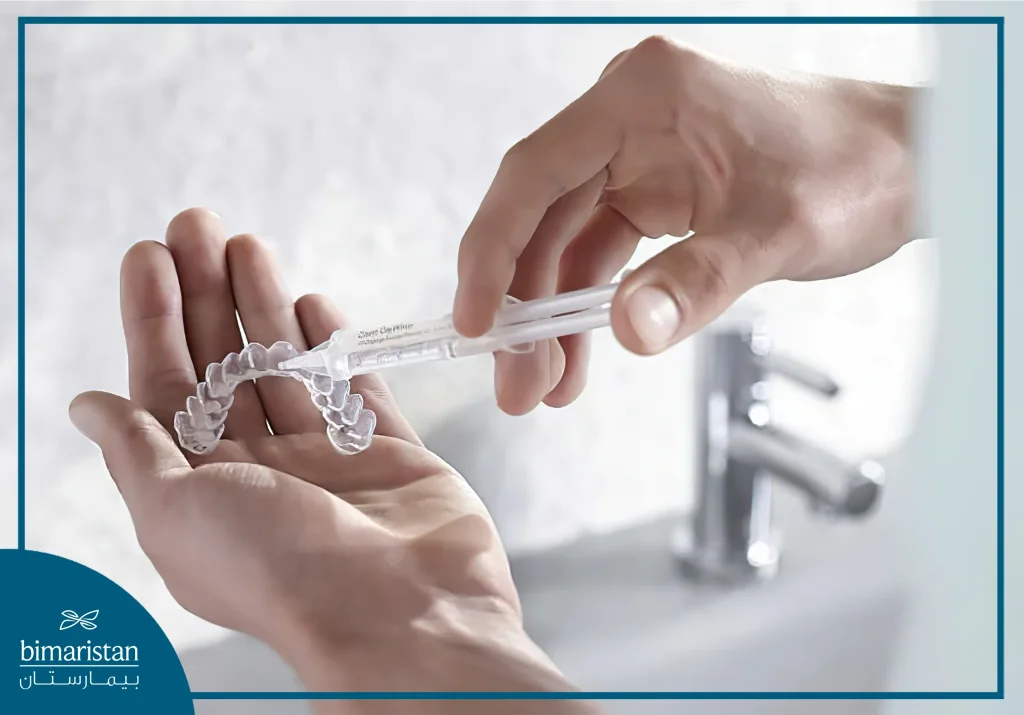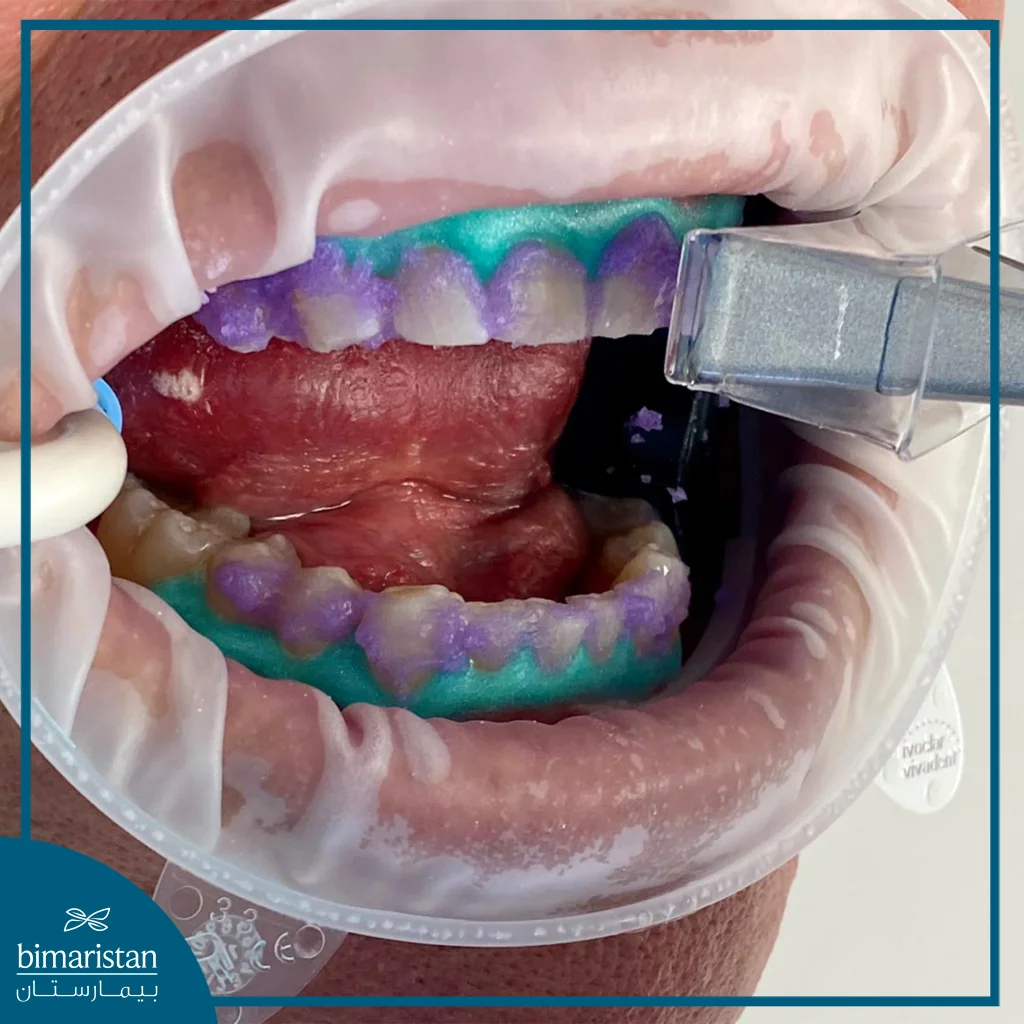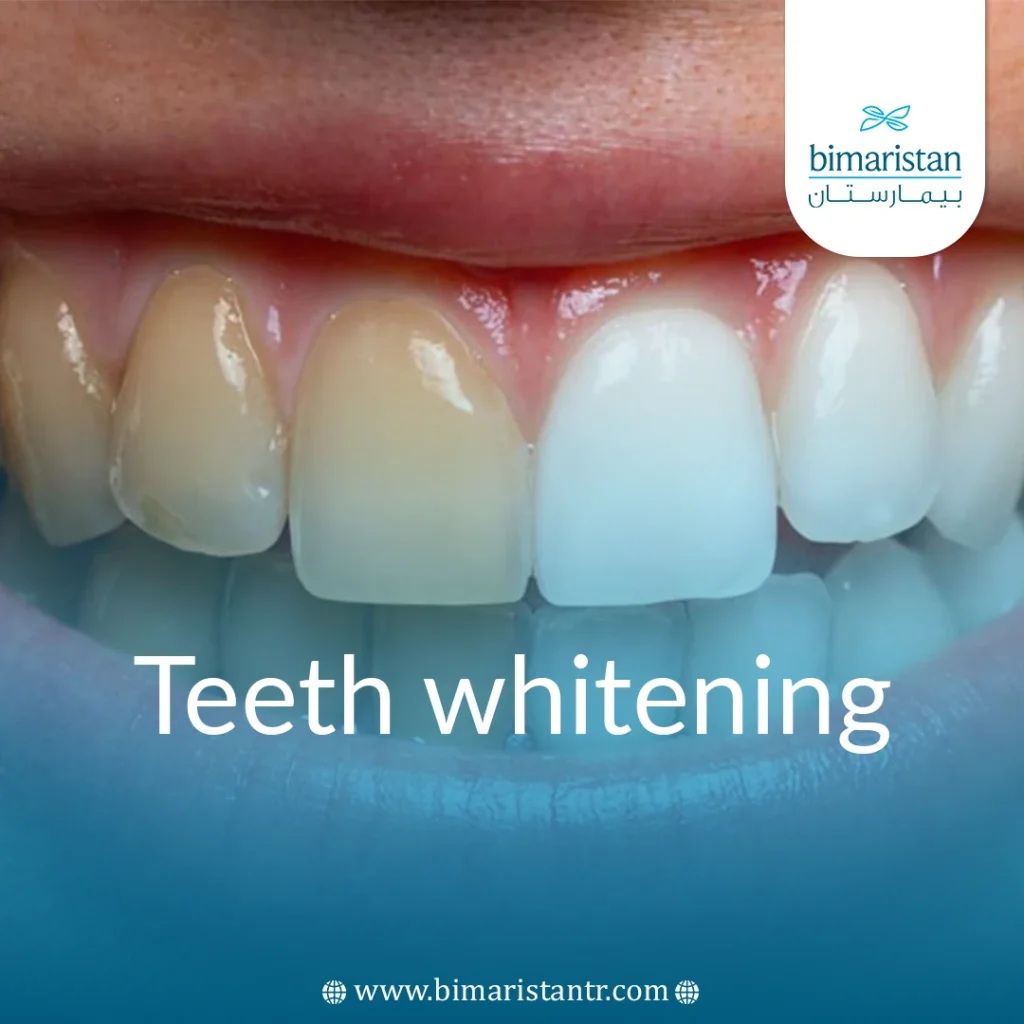Teeth whitening has become one of the most sought-after dental procedures, so many options have been found to achieve whiter teeth in Turkey.
What is teeth whitening
Teeth whitening is a procedure that aims to make the color of the teeth lighter than the existing color by several shades. Whitening is an optional procedure and is rarely necessary.
Whitening products usually use chemicals such as hydrogen peroxide or carbamide peroxide in different proportions.
The bleach penetrates through the surface enamel layer of the tooth to the dentin, where it interacts with the colored molecules that cause the tooth to change color. The dentin becomes lighter, and the teeth appear whiter. Whitening can also make the enamel surface more reflective, making it appear whiter.
Teeth whitening is a very effective way to lighten the natural color of your teeth without removing any of the surface of the teeth, knowing that it is not possible to change the color completely, but it lightens the existing color.
Just as our hair and skin colors vary, the color of our natural teeth varies from person to person. Very few people have pearly white teeth, but over time, teeth become stained by the foods and drinks we regularly consume, such as tea, coffee, and smoking, causing them to become more yellow and dark. Tartar build-up can also affect the color of your teeth, so make sure to have it removed in the clinic before deciding to have teeth whitening done.

Studies have shown that teeth whitening is safe and effective if the manufacturer’s instructions are followed. This article will discuss several methods of teeth whitening.
Laser Teeth Whitening
Laser teeth whitening is done in the clinic and is the fastest way to whiten teeth. The bleaching material is applied directly to the teeth and then exposed to a laser, heat, or special light to activate the whitening.
Although results appear in just one session of 30 to 60 minutes, several sessions are sometimes needed for better results.
The exact steps may vary depending on your needs; here’s what a typical treatment includes:
- Your dentist will place a rubber or plastic brace in your mouth to help keep it open.
- Then, you will be asked to wear goggles to protect your eyes.
- He will also add a gum barrier to protect your gums, which is a light-cured resin material.
- Your dentist will apply the whitening gel to your front teeth.
- After a few minutes, the dentist will direct the laser at your teeth.
- The laser heats the whitening gel, which activates the whitening properties.
- The dentist will remove the gum sealant and rinse off the whitening gel.
Laser teeth whitening is usually painless, though your teeth may be more sensitive than usual for 24 hours after the procedure.
This type of whitening is the most expensive method.
At-home whitening
No matter which treatment you use, there is a chance that your gums will be sensitive to the chemicals used in teeth whitening, especially if you already have sensitive teeth.
There is also a chance of gum burns, and some at-home whitening kits can damage the tooth surface or enamel.
You can whiten your teeth with some products you can try at home: rinses, whitening gels, toothpastes, and whitening strips.
If you decide to try at-home whitening, the American Dental Association suggests talking to your dentist first, especially if you have:
- Tooth Sensitivity
- Dental restorations
- Very dark stains or a single dark tooth
- Too many fillings or crowns
At-home whiteners contain peroxides, usually 10% to 20% carbamide peroxide.
Teeth whitening trays
Involve trays made by your dentist and then filled with bleaching material.
A tray for at-home whitening is generally worn for a few hours a day to every day at night for up to 4 weeks or longer, depending on the desired shade and level of whitening.

Whitening Toothpaste
All toothpastes remove surface stains because they contain mild abrasives.
Whitening toothpastes also contain a small percentage of polishing agents or chemicals, which are more effective in removing tooth discoloration.
Whitening toothpastes remove only surface stains and do not contain bleaching agents; they do not lighten the color deep inside the teeth as other in-office whitening methods do.
Whitening toothpaste can also lighten the color of teeth by about one shade, while in-office whitening can make teeth lighter by three to eight shades.
Whitening Strips and Gels
The teeth whitening gel is a clear gel containing peroxide that is applied directly to the teeth with a small brush.
Instructions vary depending on the concentration of peroxide in the solution. Initial results appear within a few days, and final results last about four months.
The full dose takes between 10 and 14 days, and you may need to apply it twice a day.
Whitening strips are very thin, almost transparent strips covered with a peroxide-containing gel. They should be applied according to the label’s instructions.
Initial results are seen within a few days; final results take about 4 months.
Whitening Mouthwash
One of the newest whitening products available is whitening mouthwash.
Like most mouthwashes, they freshen your breath and reduce dental plaque and gum disease.
However, these products also contain ingredients that help whiten teeth, such as hydrogen peroxide.
It may take up to 12 weeks to see results. Rinse for 60 seconds twice a day before brushing.
However, some experts say that mouthwashes may not be as effective as other whitening products because the whitening mouthwash is in contact with the teeth for a short period (only 2 minutes a day).
Which is better, laser teeth whitening or home teeth whitening?
There are several important differences between the two methods:
Strength of the bleaching agent
Over-the-counter home bleaching products typically contain a lower-strength bleaching agent.
Whitening trays
With home bleaching products supervised by a dentist, your dentist takes an impression of your teeth and creates custom trays to fit your teeth exactly.
This customization allows for maximum contact between the bleaching gel, which is applied to the tray, and your teeth. These trays also minimize contact of the gel with gum tissue.
Unlike the pre-made trays you buy, which come in a standard size, they do not fit precisely, causing irritation to the gums and soft tissues due to the bleaching gel seeping into them.
Additional precautions
With in-office bleaching, your dentist will either apply a gel to your gum tissue or use a rubber guard that slides over your teeth before treatment to protect your gums and oral cavity from the bleaching agents’ effects. Over-the-counter products do not provide these additional precautions.

Can you always whiten your teeth?
Whitening is not recommended or will be less successful in the following cases:
Age and pregnancy problems
Whitening is not recommended for children under 16 because the pulp chamber or nerve of the tooth is enlarged by this age.
Teeth whitening can irritate or make the pulp sensitive in this case, and it is not recommended for pregnant or breastfeeding women.
Tooth Sensitivity
Individuals with sensitive teeth, receding gums, or defective restorations should consult their dentist before using a teeth whitening system.
Anyone allergic to peroxide (the bleaching agent) should not use a whitening product.
Gum disease, enamel erosion, cavities, and exposed roots
People with gum disease or teeth with enamel erosion are generally discouraged from undergoing teeth whitening.
Before undergoing any whitening procedure, the whitening solutions penetrate any existing decay and the inner areas of the teeth, which may cause sensitivity, and whitening procedures will not work on exposed tooth roots because the roots do not contain enamel.
Fillings, crowns, and other restorations
Dental fillings and composite resin materials used in dental restorations (crowns, veneers, light fillings, bridges) do not respond to whitening.
Therefore, using whitening materials on teeth that have restorations or implants will result in uneven whitening. The unrepaired teeth will appear lighter than the restored ones, so whitening should be done before the restorations are placed.
Unrealistic expectations
Individuals who expect their teeth to be snow-white may be disappointed with the results.
Smokers should also be aware that their results will be limited unless they stop smoking, especially during the whitening process.
A healthy guide is to have a shade slightly lighter than the whites of the eyes.
Darkly stained teeth
Yellow teeth respond well to whitening, brown teeth respond less well, and gray or purple teeth may not respond at all.
The blue-gray discoloration caused by the antibiotic tetracycline is difficult to lighten and may require up to six months of home treatments or several office appointments to lighten successfully.
Dark teeth that do not respond to whitening may need another whitening option, such as veneers or crowns. Your dentist can discuss which options are best for you.
Safety Tips for Teeth Whitening in Turkey
- Follow the directions, and do not leave the bleaching agents on longer than the instructions state. Otherwise, you may end up with gum infections and other problems.
- After whitening, avoid carbonated drinks or other acidic beverages for a few hours to protect your teeth.
- Your teeth may be more sensitive after whitening, but this sensitivity usually disappears shortly.
- The gel-filled whitening trays that you place on your teeth can irritate your gums if they don’t fit properly. If you start experiencing this problem, it’s a good idea to stop using the product and see your dentist.
- After your teeth have reached the color you want, you may need to repeat the whitening sessions twice a year or less.
- Get an oral examination and cleaning first, even if you decide to whiten your teeth at home.
- Your dentist will look for cavities and check the health of your gums; it’s safer for your mouth to treat any problems before whitening.
- Ask your dentist how much lightening you can expect, as teeth darken with age, and the amount of response and color change varies from person to person.
Don’t hesitate to contact us, Bemaristan Family Center in Turkey, we offer our services extensively and accurately, free consultations around the clock.
Risks associated with whitening
The side effects that may accompany laser teeth whitening are a temporary increase in tooth sensitivity and mild irritation of the soft tissues of the mouth, especially the gums.
Tooth sensitivity often occurs during the early whitening stages, sometimes caused by tissue irritation from ill-fitting whitening trays. Symptoms are usually temporary and disappear within one to three days of stopping or completing treatment.
If you experience sensitivity, you can reduce or eliminate it by:
- Wearing the tray for a shorter period of time, for example, two 30-minute sessions instead of two 60-minute sessions.
- Stop whitening your teeth for 2 to 3 days to allow your teeth to adjust to the process.
- Ask your dentist or pharmacist about a product that contains a high percentage of fluoride, which can help remineralize your teeth. Apply the fluoride product to the tray and wear it for 4 minutes before and after the whitening process.
- Brush your teeth with a toothpaste designed for sensitive teeth. These toothpastes contain potassium nitrate, which helps calm the nerve endings in your teeth.
Some tips to keep your teeth white and fresh
- Avoid foods and drinks that cause tooth staining. Anything that contains acids can weaken teeth. To keep your smile bright, avoid sports drinks, soft drinks (light and dark), black tea, coffee, berries, white and red wine, and other colored foods, as well as sauces such as soy, curry, and tomatoes.
- Brush or rinse your teeth immediately after consuming drinks or foods that cause staining.
- Follow healthy oral hygiene practices. Brush your teeth at least twice a day, floss at least once a day to remove plaque and food debris, and rinse with an antiseptic mouthwash at least once a day to kill the bacteria that cause plaque. Use a whitening toothpaste (only once or twice a week) to remove surface stains and prevent yellowing. Use regular toothpaste the rest of the time.
- Eat foods rich in calcium. Foods high in calcium, such as cheese, can help keep your teeth white.
- Sip through a straw, which will reduce the exposure of your teeth to staining liquids.
- Consider touch-ups; depending on the whitening method used, you may need a touch-up every 6 months or every 1-2 years.
- Avoid tobacco; cigarettes, cigars, pipes, and tobacco can all stain your teeth, go without tobacco, and you’ll have brighter teeth and a healthier heart.
- If you smoke or drink a lot of staining beverages, you may need a touch-up more often.
- Get regular cleanings at your dentist’s office, which will remove plaque and food debris that can pick up stains from what you eat and drink.
Sources:
